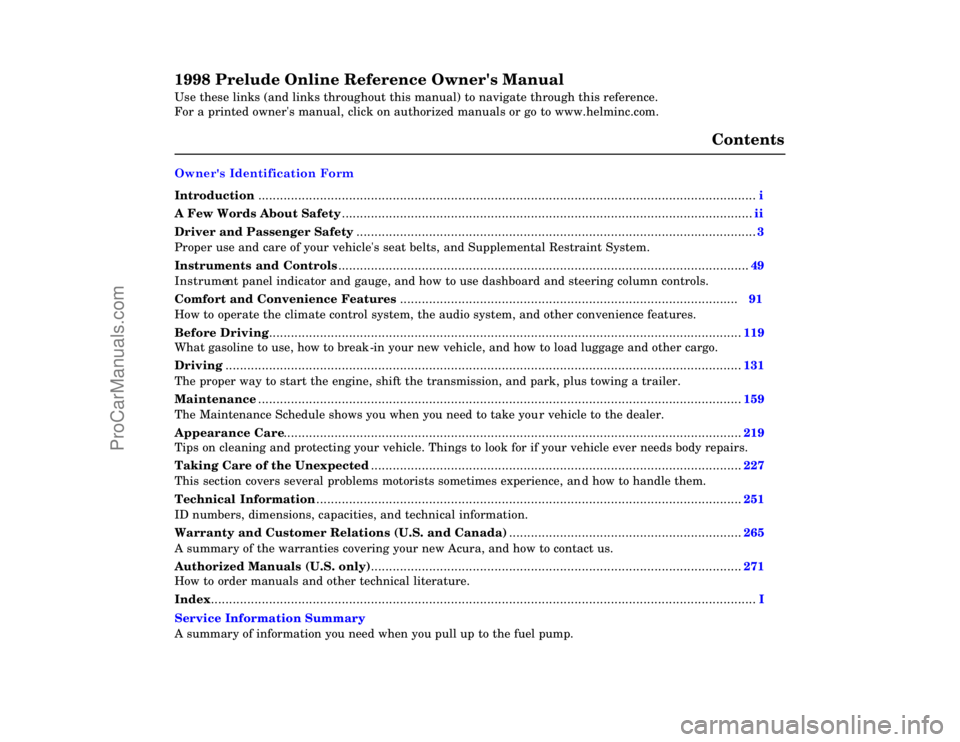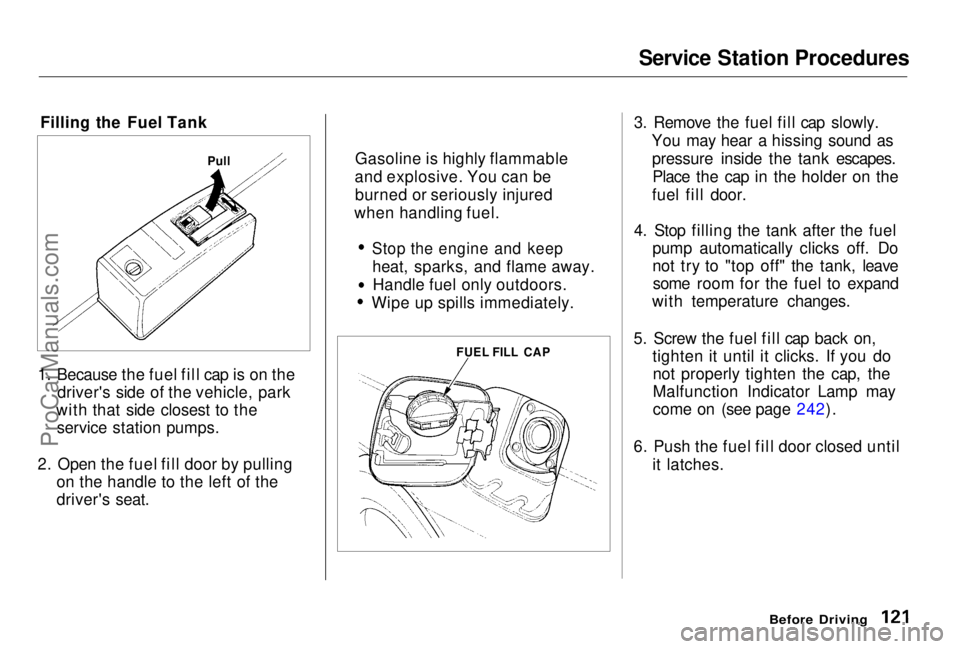fuel cap HONDA PRELUDE 1998 Owners Manual
[x] Cancel search | Manufacturer: HONDA, Model Year: 1998, Model line: PRELUDE, Model: HONDA PRELUDE 1998Pages: 278, PDF Size: 2.61 MB
Page 1 of 278

1998 Prelude Online Reference Owner's Manual
Use these links (and links throughout this manual) to navigate through\
this reference.
For a printed owner's manual, click on authorized manuals or go to www.h\
elminc.com.
Contents
Introduction ........................................................................\
................................................................. i
A Few Words About Safet y........................................................................\
.........................................ii
Driver and Passenger Safety ........................................................................\
......................................3
Proper use and care of your vehicle's seat belts, and Supplemental Restr\
aint System.
Instruments and Control s........................................................................\
.........................................49
Instrument panel indicator and gauge, and how to use dashboard and steering colu\
mn controls.
Comfort and Convenience Features ........................................................................\
..................... 91
How to operate the climate control system, the audio system, and other c\
onvenience features.
Before Driving........................................................................\
..........................................................119
What gasoline to use, how to break-in your new vehicle, and how to load luggage and other cargo.
Driving ........................................................................\
......................................................................131
The proper way to start the engine, shift the transmission, and park, pl\
us towing a trailer.
Maintenance........................................................................\
.............................................................159
The Maintenance Schedule shows you when you need to take your vehicle to the dealer.
Appearance Car e........................................................................\
..................................................... .219
Tips on cleaning and protecting your vehicle. Things to look for if your\
vehicle ever needs body repairs.
Taking Care of the Unexpecte d........................................................................\
..............................227
This section covers several problems motorists sometimes experience, and how to handle them.
Technical Informatio n........................................................................\
.............................................251
ID numbers, dimensions, capacities, and technical information.
Warranty and Customer Relations (U.S. and Canada)................................................................265
A summary of the warranties covering your new Acura, and how to contact \
us.
Authorized Manu als (U.S. only)........................................................................\
..............................271
How to order manuals and other technical literature.
Index........................................................................\
.............................................................................. I
Service Information Summary
A summary of information you need when you pull up to the fuel pump.
Accord Value Package Audio System Owner's Identification Form
ProCarManuals.com
Page 121 of 278

Service Station Procedures
Filling the Fuel Tank
1. Because the fuel fill cap is on the driver's side of the vehicle, park
with that side closest to the service station pumps.
2. Open the fuel fill door by pulling on the handle to the left of the
driver's seat. 3. Remove the fuel fill cap slowly.
You may hear a hissing sound aspressure inside the tank escapes.Place the cap in the holder on the
fuel fill door.
4. Stop filling the tank after the fuel pump automatically clicks off. Do
not try to "top off" the tank, leavesome room for the fuel to expand
with temperature changes.
5. Screw the fuel fill cap back on, tighten it until it clicks. If you donot properly tighten the cap, the
Malfunction Indicator Lamp may
come on (see page 242).
6. Push the fuel fill door closed until it latches.
Before Driving
Pull
FUEL FILL CAP
Gasoline is highly flammable
and explosive. You can be burned or seriously injured
when handling fuel.
Stop the engine and keep
heat, sparks, and flame away.Handle fuel only outdoors.
Wipe up spills immediately.ProCarManuals.comMain Menu Table of Contents s t
Page 172 of 278

Engine Oil
Adding Oil
To add oil, unscrew and remove the engine oil fill cap on top of the valve
cover. Pour in the oil, and replace the engine oil fill cap. Tighten it securely.
Wait a few minutes and recheck the oil level. Do not fill above the upper
mark; you could damage the engine. Recommended Oil
Oil is a major contributor to your
engine's performance and longevity.
Always use a premium-grade deter- gent oil.
You can determine an oil's SAE
viscosity and Service Classification from the API Service label on the oilcontainer.
A fuel-efficient oil is recommended for your Honda. This is shown on the
API Service label by the words "Energy Conserving". This oil is
formulated to help your engine use less fuel. The API Service label also tells you
the service classification of the oil.
Always use an oil that is labeled "API Service SJ". This service rating may
include other classifications, such asCD. These additional classifications
are not a problem, as long as the
label also carries the SJ classification.
CONTINUED
Maintenance
ENGINE OIL FILL CAP
API SERVICE LABELProCarManuals.comMain Menu Table of Contents s t
Page 181 of 278

Windshield Washers
Check the level in the windshield
washer reservoir at least monthly
during normal usage. In bad weather,
when you use the washers often,
check the level every time you stop
for fuel. The windshield washer reservoir is
located behind the driver's side
headlight. Check the reservoir's fluidlevel by removing the cap and
looking at the float. It should be up
to the top of the neck. If the float is at the bottom of the neck, the
reservoir is nearly empty.
Fill the reservoir with a good-quality
windshield washer fluid. This increases the cleaning capability and
prevents freezing in cold weather.
Do not use engine antifreeze or a
vinegar/water solution in the
windshield washer reservoir.
Antifreeze can damage your vehicle's
paint, while a vinegar/water solution
can damage the windshield washer
pump.
Use only commercially-available
windshield washer fluid.
Maintenance
NOTICE
FLOATProCarManuals.comMain Menu Table of Contents s t
Page 239 of 278

Malfunction Indicator Lamp
This indicator comes on for a few seconds when yon turn the ignition
switch ON (II). If it comes on at any
other time, it indicates one of the
engine's emissions control systems
may have a problem. Even though
you may feel no difference in your
vehicle's performance, it can reduce
your fuel economy and cause your
vehicle to put out excessive emissions. Continued operation may
cause serious damage. If you have recently refueled your
vehicle, the cause of this indicator coming on could be a loose or
missing fuel fill cap. Check the cap
and tighten it until it clicks. Replace
the fuel fill cap if it is missing.
Tightening the cap will not make the indicator turn off immediately; it
takes three driving trips.
If the indicator remains on past threedriving trips, or the fuel cap was not
loose or missing, have the vehicle
checked by the dealer as soon as
possible. Drive moderately until the dealer has inspected the problem.
Avoid full-throttle acceleration and driving at high speed.
You should also have the dealer inspect your vehicle if this indicator
comes on repeatedly, even though it
may turn off as you continue driving.If you keep driving with the
malfunction indicator lamp on, you can
damage your vehicle's emissionscontrols and engine. Those repairs may
not be covered by your vehicle 's warranties.
Taking Care of the Unexpected
MALFUNCTION INDICATOR LAMP
NOTICE
ProCarManuals.comMain Menu Table of Contents s t
Page 248 of 278

Technical Information
The diagrams in this section give you the dimensions and capacities of
your Honda, and the locations of the identification numbers. The expla-
nations of several electronic and mechanical systems on your Honda
are for the more technically-oriented
owner. Identification Numbers................. 252
Specifications................................. 254
Tire Information............................ 256 Tire Size Designation................ 256
Wheel Size Designation............ 256
Tire Speed Ratings.................... 256 Tire Pressure Adjustment For High Speed Driving........ 257
DOT Tire Quality Grading....... 257 Treadwear.............................. 257
Traction.................................. 258
Temperature.......................... 258 Oxygenated Fuels.......................... 259
Driving in Foreign Countries....... 260
Emissions Controls........................ 261
The Clean Air Act...................... 261Crankcase Emissions Control System..................................... 261
Evaporative Emissions Control System..................................... 261
Exhaust Emissions Controls.... 262 PGM-FI System..................... 262
Ignition Timing ControlSystem................................. 262
Exhaust Gas Recirculation (EGR) System.................... 262
Three Way Catalytic
Converter............................ 262
Replacement Parts..................... 262
Three Way Catalytic Converter... 263
Technical InformationProCarManuals.comMain Menu s t
Page 272 of 278

Index
Emergency Brake............................ 84
Emergency Flashers....................... 63
Emission Controls......................... 261
Engine
Coolant Temperature Gauge ..... 57
Malfunction Indicator Lamp................................. 53, 242
Oil Pressure Indicator......... 53, 240
Oil, What Kind to Use............... 173
Overheating................................ 238
Specifications............................. 254
Ethanol in Gasoline ....................... 259
Evaporative Emission Controls.... 261
Exhaust Fumes................................ 47
Expectant Mothers, Use of Seat Belts by.........................................17
Exterior, Cleaning the................... 220
Fabric, Cleaning............................. 222
Fan, Interior...................................... 92
Features, Comfort and Convenience................................. 91
Filling the Fuel Tank..................... 121 Filters
Air................................................187
Oil................................................175
First Gear, Shifting........................ 142 5-speed Manual Transmission Checking Fluid Level................ 184
Shifting the................................. 134
Flashers, Hazard Warning.............. 63
Flat Tire, Changing a.................... 229
Fluids Automatic Transmission........... 183
Brake...........................................185
Clutch..........................................186
Manual Transmission............... 184
Power Steering........................... 186
Windshield Washer................... 182
FM Stereo Radio
Reception.................................... 105
Folding Rear Seat............................ 79
Foreign Countries, Driving in...... 260 Four-way Flashers........................... 63
Front End, Towing by
Emergency Wrecker................. 250
Fuel..................................................120
Fill Door and Cap....................... 121
Gauge............................................ 57
Octane Requirement................. 120
Oxygenated................................ 259
Reserve Indicator......................... 55
Tank, Filling the......................... 121
Fuses, Checking the...................... 245
Gas Mileage, Improving................ 125
Gasohol........................................... 259
Gasoline.......................................... 120 Fuel Reserve Indicator................ 55
Gauge............................................ 57Octane Requirement................. 120
Tank, Filling the......................... 121
Gas Station Procedures................. 121
Gauges
Engine Coolant Temperature .... 57
Fuel................................................57
Gearshift Lever Positions Automatic Transmission........... 137
5-speed Manual
Transmission.......................... 134
Glass Cleaning............................... 223
Glove Box......................................... 74ProCarManuals.comMain Menu s t
Page 278 of 278

Service Information Summary
Gasoline:
Premium Unleaded gasoline,
pump octane number of 91 or
higher.
Fuel Tank Capacity:
15.9 US gal (60l,13.2 Imp gal)
Recommended Engine Oil:
API Service SJ "Energy Conserving" oil, SAE 5W-30
viscosity (see page 173).
Oil change capacity (including
filter):
5.1 US qt (4.8 l,4.2 Imp qt)
Automatic Transmission Fluid:
Honda Premium Formula
Automatic Transmission Fluid
preferred, or a DEXRON ®
III ATF
as temporary replacement (see page 183).
5-speed Manual Transmission
Fluid:
Honda Manual TransmissionFluid preferred, or an API service
SG, SH or SJ, 10W-30 or 10W-40 motor oil as a temporaryreplacement (see page 184).
Capacity (including differential):
Type SH
2.2 US qt (2 .
1 l,1.8lmpqt)
Except Type SH
2.0 US qt (1.9 l,1.7lmpqt)
Power Steering Fluid:
Genuine Honda Power Steering Fluid preferred, or another brand
of power steering fluid as a
temporary replacement. Do not
use ATF (see page 186).
Brake Fluid:
Genuine Honda DOT3 Brake Fluidpreferred, or a DOT 3 or DOT 4
brake fluid as a temporaryreplacement (see page 185).
Tire Pressure (measured cold):
Front/Rear:
32 psi (220 kPa , 2.2 kgf/cm2)
ProCarManuals.comMain Menu s t